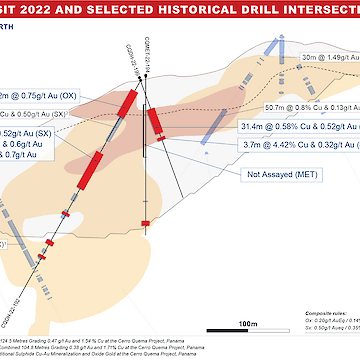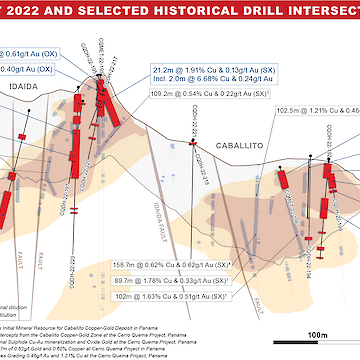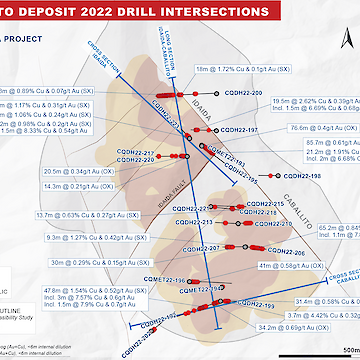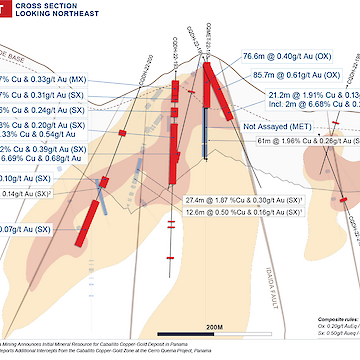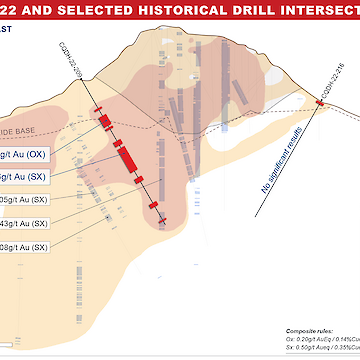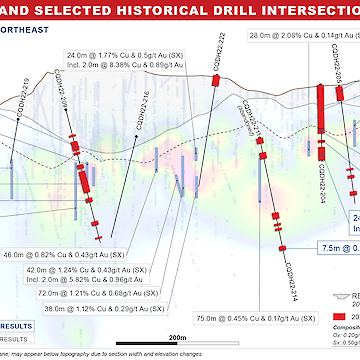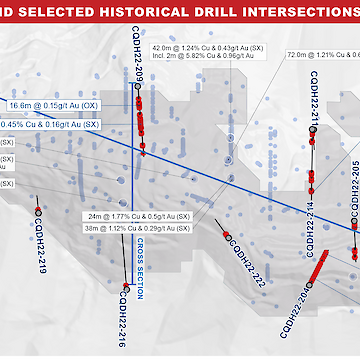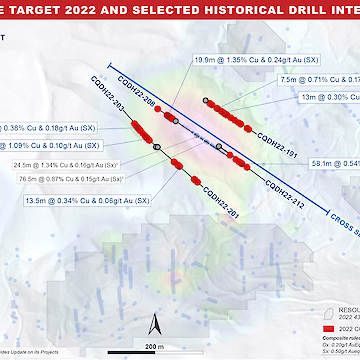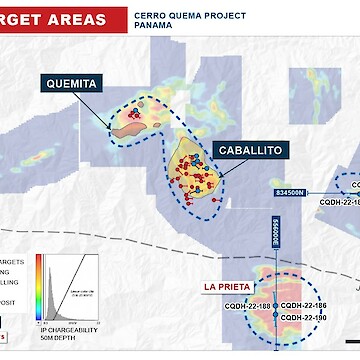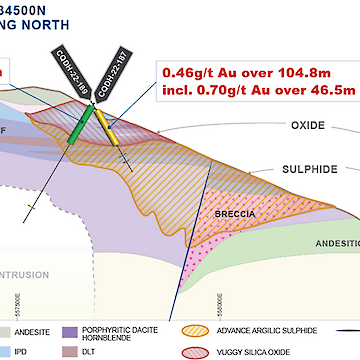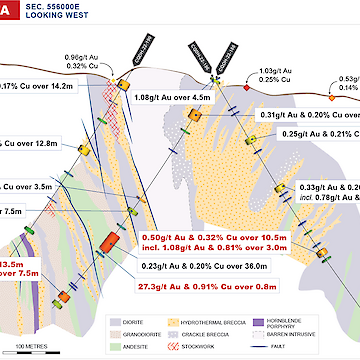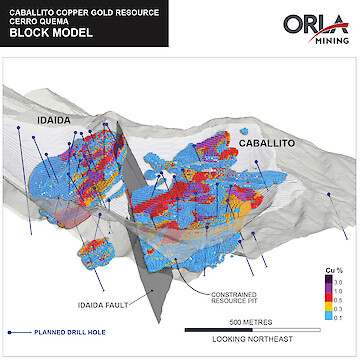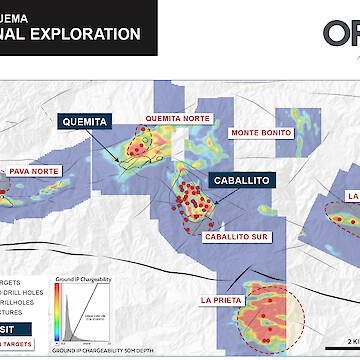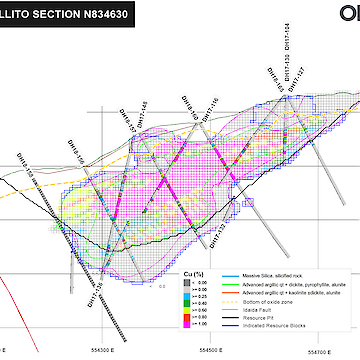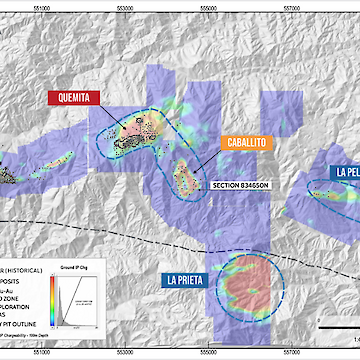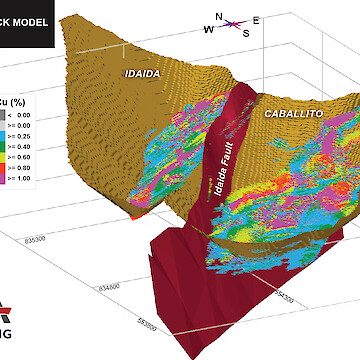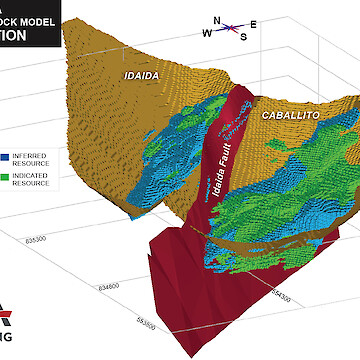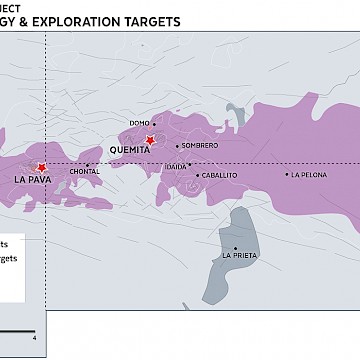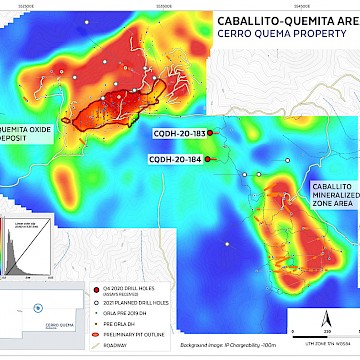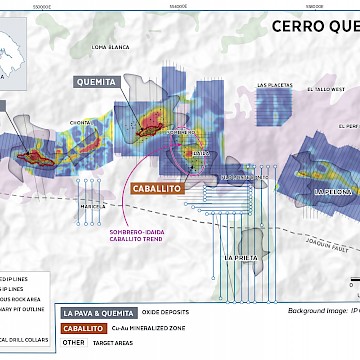Assets
Geology & Exploration
Panama (14,893 hectares)
The discovery of the Caballito mineralized zone and follow-up drilling executed by Orla led to the definition of significant copper and gold sulphide mineralization with open pit potential. The Caballito-style mineralization differs from the Pava and Quemita oxide deposits as it consists of copper-gold (low arsenic) sulphide mineralization that will not be amenable to heap leaching and will require a different processing method. The Cerro Quema property shows potential for additional oxide mineralization, and the upside resides within the sulphide-hosted mineralization in an area that is largely under-explored.
Geology & Mineralization
The Cerro Quema project lies within an elongate belt of Upper Cretaceous to Paleocene island-arc volcanic and plutonic rocks characterized by andesitic and dacitic flow-domes, associated pyroclastic rocks, and diorite to granodiorite intrusions. Volcanic rocks lie atop Upper Cretaceous marine sedimentary rocks and submarine pillow basalts. High-sulfidation epithermal prospects and deposits containing gold and copper mineralization are hosted by advanced argillic-altered volcanic rocks. District-scale alteration extends along a WNW trend for >10 kilometres within the limits of Orla’s 14,833 hectare concession. At the eastern part of the trend, the La Pava and Quemita gold deposits are at development stage for a proposed open pit mine processed by heap leaching an oxidized mineral reserve of 0.5 million ounces gold. The remaining western part (>6 km) is at exploration stage for additional Au oxide and Cu-Au sulphide resources.
Zones of intense hydrothermal alteration that host the gold and copper mineralization consist of secondary quartz-rich rock enveloped by quartz – dickite ± kaolinite ± alunite ± pyrophyllite ± diaspore (advanced argillic alteration), illite – smectite ± pyrite (intermediate argillic alteration), and a distal zone of chlorite – illite – smectite – calcite (propylitic alteration). Secondary quartz predominately occurs as vuggy silica that formed by intense hypogene acidic leaching of the original volcanic rocks. The vugs developed below the water table as rising magmatic vapors condensed and generated acidic fluids that leached feldspar and mafic minerals out of the rock leaving only a dense residual quartz matrix surrounding empty phenocryst sites. Other quartz-rich rocks include massive silica that developed where fluids cooled and mixed near the water table precipitating quartz (silicification) in breccia and vugs of the vuggy silica.
Oxidized and mineralized vuggy silica crops out on topographic highs at the La Pava and Quemita gold deposits. Oxide mineralization, consisting of gold with iron oxides and sulfates, extends from surface to depths up to 150 metres below surface. The highest grades of gold mineralization occur within crackled and brecciated feeder structures containing abundant supergene jarosite-goethite-hematite after hypogene pyrite-enargite-chalcopyrite. Surface gold enrichment was noted in the feeder structures on the southern margin of the La Pava deposit.
Vuggy silica also crops out on topographic highs at the Idaida and Pelona prospects, 1.5- and 4.5-kilometres ESE of Quemita, respectively. Anomalous gold in vuggy silica with iron oxide is present at surface in both areas. Gold and copper mineralization in sulphide at depth below Idaida is associated with pyrite-covellite-enargite-chalcopyrite. Little is known about the sulphide mineralization at Pelona where limited drilling in oxide returned low gold grades.
Caballito (Copper-Gold Discovery)
Orla’s Caballito Cu-Au zone is a new mineral discovery in a topographic low situated 1.5 kilometres SE from the Quemita deposit adjacent Idaida and 4.8 kilometres ESE from the La Pava deposit. Caballito is a high-grade, copper-dominant, high-sulfidation style epithermal system hosted in Upper Cretaceous submarine dacitic volcanic rocks and may have been localized along permeable horizons of dacitic hyaloclastites. Mineralization consists predominately of Cu-Au sulphide from depths of ~40-200 meters below unaltered dacite and a thin veneer of lateritic soils. Caballito was a blind discovery in steep jungle terrain guided by IP-EM geophysics and scout drilling (discovery holes include CQDH17-089, 104 and 116). Average copper grades range from 0.5 to >1.8% with gold ranges from 0.2 to 0.4 g/t.
The Cu-Au zone developed as a stratiform hydrothermal breccia within a zone of quartz-enriched rocks defined by a central core of vuggy silica that is progressively enveloped by quartz – dickite alunite to quartz – kaolinite ± dickite (advanced argillic alteration), illite – smectite – pyrite (intermediate argillic alteration), chlorite – illite – smectite – calcite (propylitic alteration) to unaltered dacitic volcanic rocks. The breccia features high-sulfidation state sulfides (pyrite-enargite-covellite) together with sulfides of intermediate sulfidation states (bornite-chalcocite) and contains fragments of vuggy silica with euhedral pyrite – enargite ± chalcopyrite (high temperature, low pH) cemented with quartz, colloform-textured granular and spheroidal pyrite (low temperature, increased pH), bornite and chalcocite. Preliminary ore petrography at Caballito indicates that bornite replaced chalcopyrite, chalcocite replaced bornite, and covellite replaced rims of chalcocite. Adjacent the stratiform breccia, at the Idaida prospect, the hydrothermal breccia plunge is sub-vertical and may represent a feeder zone for Caballito. Hypogene covellite replaced enargite in the Idaida breccia enhancing copper grades and reducing arsenic concentrations. Numerous dikes of quartz diorite, diorite and basaltic-andesite, with variable illite – smectite alteration, intruded both the Idaida and Caballito breccia.
Orla is exploring a 6 kilometre WNW-ESE trend for high-grade Cu-Au sulphide from the Quemita Au-deposit through Caballito to Pelona, as well as potential zones for Cu-Au sulfide in a quartz diorite intrusion to the south at La Prieta.
2022 Exploration
The 2022 Cerro Quema exploration program will consist of infill and expansion drilling of known deposits, drill testing exploration targets defined by recent geochemical soil sampling, geophysical Induced Polarization (IP) surveys, bedrock mapping and prospecting, and historical drilling. In total, 11,700m of drilling is planned in 2022 for Panama.
Caballito Deposit Infill and Expansion Drill Program:
Infill and expansion drilling at Caballito, and more limited drilling at La Pava and Quemita, will be directed at converting resources from the inferred resource to indicated resource category, provide material for metallurgical testing, and test the continuity of mineralization and potential extensions of these deposits. The first resource estimates of copper-gold sulphide mineralization at La Pava and Quemita is planned for late 2022.
Cerro Quema Regional Exploration:
Exploration target drill testing is planned to the north of the Quemita deposit to follow-up on hole CQDH-17-112 (previously reported), which intersected 76.5m at 0.87% Cu, 0.15 g/t Au (from 68.0m to 144.5m).[1]
Drilling is also planned at the La Pelona target, which has a similar geophysical signature and geological context to La Pava and Quemita and has limited historical drilling. Drilling will be following up on historical drilling, which intersected oxide mineralization from surface, including 0.23 g/t Au over 138m, and boulder samples which have returned assays of up to 1.8 g/t Au.[2]
South of the regional Joaquin Fault, La Prieta will also be drill tested. La Prieta is defined by a 1.4 km diameter IP chargeability anomaly with coincident Au, Cu, and Mo in-soil and in-rock geochemical anomalies which may be indicative of porphyry-style Cu-Au mineralization.
Other regional targets such as the Quemita Norte’s Cu-in-soil anomaly and Monte Bonito, which is north-east of Quemita, will also be considered for drilling in 2022.
[1] See the Company’s August 23, 2017 news release titled “Orla Provides Update on its Projects”, for full detail on the drill program upon which this drill result was based.
[2] These drill intercepts and boulder samples are historical in nature and are not treated by the Company as current. Such results were completed by Cyprus Minerals Company, a prior owner of the Cerro Quema Project, prior to the adoption of NI 43-101. The Company is conducting drilling to verify these historical results.
Maps


